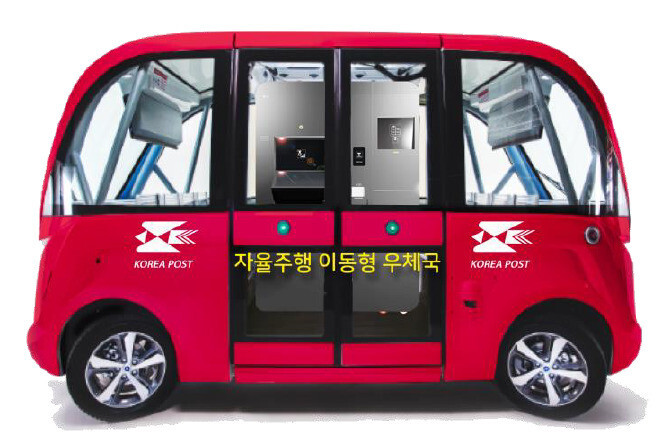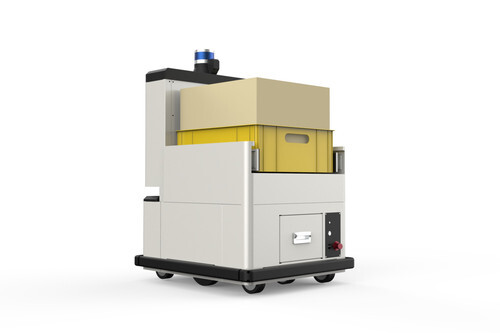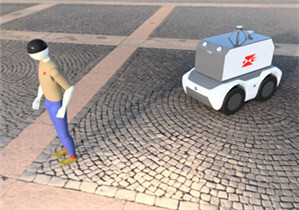hankyoreh
Links to other country sites 다른 나라 사이트 링크
Korea Post developing app that employs network of self-driving “mobile post offices "

“After you order a delivery through the postal service app, an automated, self-driving mobile post office will arrive at your door at the appointed time. Open the vehicle door with a unique number code and the delivery will be conveyed automatically. All you need to do is open the door of the automated, self-driving mobile post office vehicle in front of your home and collect your item as you would when you receive a normal delivery.”
This is the future vision for the automated, self-driving mobile post office service, which the Ministry of Science and ICT-affiliated Korea Post headquarters announced would be entering pilot operation as early as this October.
Pilot operation to extend for 21 months through end of 2021
On May 28, Korea Post held a briefing session on the launch of its self-driving postal distribution technology project, during which it announced that it was launching full-scale development of postal distribution service technology that incorporates AI and self-driving vehicles. At a time when concerns are being raised about transmission of COVID-19 through major logistics centers such as those of Coupang, demand for “untact” services without direct human contact is growing. Korea Post is focusing on innovations for future delivery services.
The untact delivery services that Korea Post is implementing include three forms of equipment and systems: unmanned self-driving mobile post offices, postal delivery robots, and postal worker-piloted robots.
Once a delivery or item of registered mail is received and paid for via the Korea Post app, the self-driving mobile post office vehicle will travel to the designated location by itself for an unmanned delivery. Users who are receiving registered mail or packages need only enter the code for the self-driving mobile post office’s carrying box at the designated time and place with their Korea Post app. The mobile post offices are scheduled for pilot operation as early as October in designated smart cities and special self-driving vehicle districts.
The postal delivery robots are mainly to be used as a last mile delivery service for university campuses and large apartment complexes. As with the self-driving mobile post offices, users can request pickup through the Korea Post app, after which the delivery robot will travel to the appointed location. The delivery can be collected by entering a code sent to the user’s smartphone in advance.

The postal worker-piloted robots served as delivery “assistants” to carry heavy packages for delivery. The robots travel automatically to a package storage location and transport the items to the postal workers for delivery. With the piloted robots carrying the load, postal workers are able to focus on deliveries.
Pilot operation is scheduled to begin in actual distribution environments such as post offices and postal distribution centers through joint development by South Korean SMEs and venture enterprises. The period is scheduled to extend for 21 months through the end of 2021.
Park Jong-seok, head of the Postal Service Group at Korea Post, said the “development of technology applying scientific technology and ICT will mark an inflection point for changes to postal services.”
“Greater efficiency and automation of distribution through the use of new technology will bring historical improvements to working environments for postal workers, including reduced duties and accident prevention,” he predicted.
By Koo Bon-kwon, staff reporter
Please direct comments or questions to [english@hani.co.kr]

Editorial・opinion
![[Column] Season 2 of special prosecutor probe may be coming to Korea soon [Column] Season 2 of special prosecutor probe may be coming to Korea soon](https://flexible.img.hani.co.kr/flexible/normal/500/300/imgdb/original/2024/0426/3317141030699447.jpg) [Column] Season 2 of special prosecutor probe may be coming to Korea soon
[Column] Season 2 of special prosecutor probe may be coming to Korea soon![[Column] Park Geun-hye déjà vu in Yoon Suk-yeol [Column] Park Geun-hye déjà vu in Yoon Suk-yeol](https://flexible.img.hani.co.kr/flexible/normal/500/300/imgdb/original/2024/0424/651713945113788.jpg) [Column] Park Geun-hye déjà vu in Yoon Suk-yeol
[Column] Park Geun-hye déjà vu in Yoon Suk-yeol- [Editorial] New weight of N. Korea’s nuclear threats makes dialogue all the more urgent
- [Guest essay] The real reason Korea’s new right wants to dub Rhee a founding father
- [Column] ‘Choson’: Is it time we start referring to N. Korea in its own terms?
- [Editorial] Japan’s rewriting of history with Korea has gone too far
- [Column] The president’s questionable capacity for dialogue
- [Column] Are chaebol firms just pizza pies for families to divvy up as they please?
- [Column] Has Korea, too, crossed the Rubicon on China?
- [Correspondent’s column] In Japan’s alliance with US, echoes of its past alliances with UK
Most viewed articles
- 1No good, very bad game for Korea puts it out of Olympics for first time since 1988
- 2[Column] Season 2 of special prosecutor probe may be coming to Korea soon
- 3Korea’s 1.3% growth in Q1 signals ‘textbook’ return to growth, says government
- 4‘We must say no’: Seoul defense chief on Korean, USFK involvement in hypothetical Taiwan crisis
- 5Is N. Korea threatening to test nukes in response to possible new US-led sanctions body?
- 6Division commander ordered troops to enter raging flood waters before Marine died, survivor says
- 7[Column] ‘Choson’: Is it time we start referring to N. Korea in its own terms?
- 8Will NewJeans end up collateral damage in internal feud at K-pop juggernaut Hybe?
- 9Korea sees more deaths than births for 52nd consecutive month in February
- 10[Editorial] Korea’s surprise Q1 growth requires objective assessment, not blind fanfare